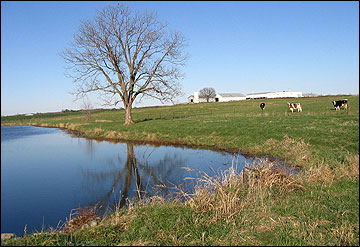
Figure 1
Runoff from agricultural fields can have a large impact on water quality of streams and lakes.
To understand why nutrient management is important on your farm, you need to appreciate how nutrients affect water quality. This guide answers frequently asked questions about the relationship between nutrients and water quality.
What do we mean by "nutrients"?
Nutrients are mineral compounds needed by all living things to grow and thrive. In most land and water systems, the limited availability of certain nutrients reduces growth of plants and animals.
For example, consider a corn crop growing in a field. The corn plant extracts minerals needed for growth from the soil. These include nitrogen, phosphorus, potassium, sulfur, calcium, iron and many others. Most of these minerals are abundantly available in the soil and the corn plant's needs are easily met by what is in the soil. However, many soils have too little of some minerals and crops grown on these soils without fertilizers will have lower yields.
Unfertilized Missouri soils are frequently low in nitrogen, phosphorus and potassium. Nitrogen is usually the most limiting nutrient for plant growth in land-based systems like a cornfield. It is usually profitable to farmers to purchase and apply nitrogen fertilizer to corn. The value of the yield increase from the added nutrients more than offsets the cost of the purchased fertilizer.
How do nutrients affect water quality?
Streams and lakes have many similarities to that cornfield. Plants and fish use nutrients from the water to fuel their growth. The amount of aquatic growth in many streams and lakes in Missouri is limited by the amount of nutrients in the water. For example, southwest Missouri is known for the clarity of its lakes and streams. Water clarity is due, in part, to a lack of plant and animal growth in pristine water resources in this part of the state. The waters in this part of the state naturally have very low levels of phosphorus, limiting plant and fish growth.
The use of fertilizers and manures on agricultural land, golf courses and lawns increases the amount of nutrients reaching a stream. As more nutrients reach a stream or lake, they act like a fertilizer to increase plant growth. Users of the stream will notice the effect of more nutrients including a reduction in water clarity because of increased growth of plants and algae. Fertilizers increase the growth of plants in water just as fertilizers increase corn growth on land.
The nutrients limiting algae growth in fresh water are different from those limiting corn growth. Phosphorus is typically the most limiting nutrient in fresh water. Consequently efforts to improve stream and lake water quality focus on reducing phosphorus losses from fields to streams and lakes.
How are nutrients lost from agricultural fields?
Nutrients move into water resources by three pathways:
- Water moving as runoff across the surface of the soil carries nutrients.
- Soil particles eroded by surface water runoff carry many nutrients. Erosion is one of the major mechanisms contributing phosphorus to streams and lakes.
- Runoff water passing over the soil surface picks up dissolved nutrients. Runoff soon after manure and other fertilizer applications can carry high concentrations of dissolved nutrients.
- Water infiltrating into the soil can percolate through the soil carrying nutrients.
- As the water passes through the soil matrix, the soil acts as a filter removing some nutrients. Nitrate nitrogen is one of the most mobile nutrients because it is not removed from water passing through the soil.
- Water can bypass the soil filter if it moves downward through soil cracks and root channels. This nutrient-rich water resembles surface water runoff and can be a particular problem on soils with tile drainage or a high water table and on thin soils overlaying fractured limestone.
- Nutrients, primarily nitrogen as ammonia or nitrogen gas, can be lost to the air. Ammonia will eventually return to the soil, streams and lakes through rainfall events.
- Large ammonia losses are mostly associated with manure storage facilities such as lagoons.
What can I do to limit nutrient losses from my farm?
The following strategies will help reduce nutrient losses from agricultural fields.
- Match nutrient applications to crop needs, particularly for mobile nutrients such as nitrogen.
- Time applications to match crop demand for mobile nutrients such as nitrogen.
- Time surface applications to avoid periods when runoff is likely.
- Avoid surface applications on snow-covered, frozen or saturated fields.
- Minimize erosion.
A nutrient management plan will provide guidance on how to implement these strategies for protecting water quality on your farm.